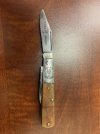Having done modifications to both springs and tangs, I respectfully disagree.
What I described in my earlier post is perfectly reasonable and I know from my own experience that it works. Specifically, I know that overcoming the initial force of opening the blade can be accomplished by only filing one small area of the blade tang, while leaving the rest untouched, thus not affecting the fully deployed position of the knife. To me this is the most logical and practical approach requiring the least amount of modification.
On the other hand, any time you modify the spring, you structurally weaken it, which can lead to problems. It's more risky. And while it may turn out fine, the fact remains that it's not a necessary risk to take, at least not in this particular situation.
I don't argue with the experience of others, nor do I argue to prove the success of my experience. If you say that your method worked for you, more power to you. More than one way to skin a cat.
If I read hsherzfelds issue right, he's having difficulty overcoming the spring when initially lifting the blade from the closed/fully seated position.
As far as removing steel from the tang, the only way to make it easier to lift the blade from the closed/fully seated position is to remove steel from the part of the tang that holds the blade
in the closed/fully seated position. And removing any steel from the tang that holds the blade in the closed/fully-seated position increases the risk of negatively affecting how the blade sits when closed. Like possibly creating blade-peek, or the reverse- causing the blade to sit too deep and preventing one from getting their nail in the nail nick.
I didn't say anything about affecting the blade in the "fully deployed position".
If hshezfelds problem was, say, overcoming the halfway point during opening, then removing steel from the butt-end/bottom of the tang would, in my opinion, be an appropriate solution, and one that would not affect the blade in either the closed or fully-open position. But that doesn't sound like his problem.
Of course any modification to a knife, particularly removing steel from either the tang of the blade, or the spring, comes with risk. Whatever method hsherzfeld uses, I hope he can resolve the issue. One word of advice I would give him if he chooses to remove steel from the spring is to make sure he doesn't remove any from where the kick of the blade contacts the spring, otherwise that would affect how the blade sits when closed.
As far as our difference of opinion, I will respectfully agree to disagree

.



